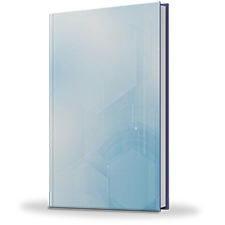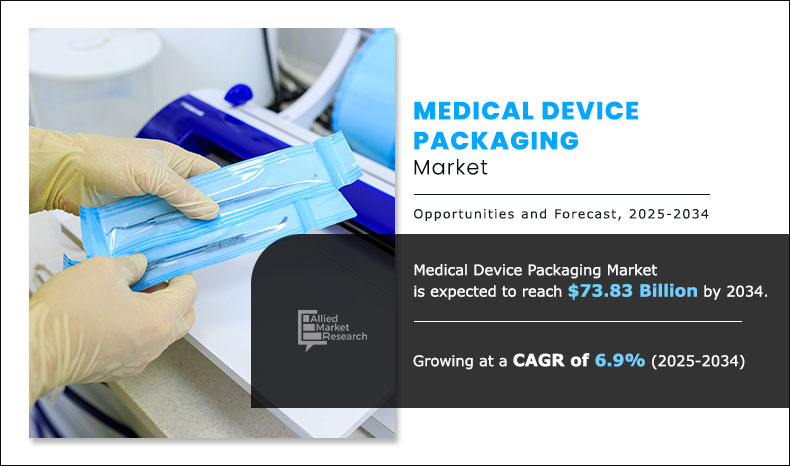Medical Device Packaging Market Research - 2034
The medical device packaging market size was valued at $37,725.22 million in 2024 and is estimated to reach $73,830.16 million by 2034, exhibiting a CAGR of 6.9% from 2025 to 2034.
The growth of the medical device packaging market is driven by the rising demand for safe, sterile, and effective packaging solutions, particularly due to the growing volume of medical devices and the increasing emphasis on infection control and patient safety. For instance, according to the World Health Organization (WHO), an estimated 234 million major surgical procedures are performed worldwide each year, underscoring the critical need for reliable packaging to ensure sterility and device integrity until the point of use. The expanding global healthcare infrastructure and rising prevalence of chronic diseases are further fueling demand, creating sustained growth opportunities for the medical device packaging market.
Medical device packaging refers to specialized packaging systems designed to protect medical instruments, implants, diagnostic devices, consumables, and surgical equipment from contamination, mechanical damage, and environmental factors. These packaging solutions such as pouches, trays, clamshells, blister packs, and wraps are developed using materials like Tyvek, polyethylene, polypropylene, laminates, and medical-grade paper to ensure barrier protection, durability, and compliance with stringent regulatory standards. Packaging not only maintains product sterility but also supports ease of handling, tamper evidence, and traceability throughout the supply chain. Medical device packaging is integral to applications across hospitals, ambulatory surgical centers, diagnostics, and home healthcare, due to its critical role in ensuring device safety and performance, which is driving its global adoption and medical device packaging market expansion.
Key Takeaways
- On the basis of material type, the plastic films segment dominated the medical device packaging market in terms of revenue in 2024. However, the high density spunbond polyethylene fibers/LDPE/polyolefin segment is anticipated to grow at the fastest CAGR during the forecast period.
- On the basis of type, the primary segment dominated the medical device packaging market in terms of revenue in 2024 and is anticipated to grow at the fastest CAGR during the forecast period.
- On the basis of application, the others segment dominated the medical device packaging market in terms of revenue in 2024 and is anticipated to grow at the fastest CAGR during the forecast period.
- Region wise, North America generated the largest revenue in 2024. However, Asia-Pacific is anticipated to grow at the highest CAGR during the forecast period.
Market Dynamics
The growth of the medical device packaging market is primarily driven by the rising global demand for medical devices, fueled by the increasing prevalence of chronic diseases, the growing geriatric population, and the surge in surgical and diagnostic procedures worldwide. As healthcare systems expand and patient volumes rise, there is a parallel need for safe, sterile, and effective packaging solutions that can preserve device integrity throughout transportation, storage, and usage. One of the key drivers is the heightened focus on infection prevention and patient safety, as packaging plays a critical role in maintaining sterility and reducing the risk of contamination. Additionally, the expansion of minimally invasive procedures and the growing adoption of disposable medical devices have further boosted the demand for innovative packaging formats such as sterile pouches, thermoformed trays, and blister packs. Regulatory requirements set by agencies such as the U.S. FDA and the European Medicines Agency also drive medical device packaging market growth, as compliance with these strict guidelines compels manufacturers to adopt advanced packaging materials like Tyvek, high-barrier films, and medical-grade paper to ensure product safety and efficacy. Another significant driver is the rising trend of home healthcare and self-administration of medical treatments, which necessitates packaging designs that are user-friendly, tamper-evident, and portable. Moreover, the increasing integration of smart packaging technologies, such as RFID tags and QR codes, is enhancing traceability and supply chain transparency, creating additional growth momentum in the medical device packaging market.
However, the medical device packaging market faces certain restraints that could hinder its expansion. One of the major challenges is the high cost associated with specialized packaging materials and advanced sterilization processes. Manufacturers are under constant pressure to balance regulatory compliance with cost efficiency, and the price sensitivity of healthcare systems, especially in developing economies, can limit the adoption of high-end packaging solutions. The complexity of adhering to different regulatory frameworks across regions also creates barriers, as packaging solutions must meet diverse standards related to safety, labeling, and sustainability. Another restraint is the growing environmental concern regarding the use of non-biodegradable plastics and multilayer films in medical packaging. With stricter global regulations on plastic waste management and sustainability goals set by healthcare providers, manufacturers are challenged to innovate eco-friendly packaging solutions without compromising sterility or performance. Supply chain disruptions, as seen during the COVID-19 pandemic, also highlighted vulnerabilities in raw material availability and distribution channels, further straining the medical device packaging market. In addition, the risk of counterfeit medical devices entering the supply chain presents an ongoing concern, emphasizing the need for secure packaging solutions but simultaneously creating additional compliance and cost burdens for manufacturers.
Moreover, these challenges open significant opportunities for growth and innovation in the medical device packaging market. One of the most promising opportunities lies in the development of sustainable and eco-friendly packaging solutions, such as recyclable plastics, bio-based polymers, and paper-based alternatives, which align with global sustainability initiatives while addressing environmental concerns. Companies that can deliver green packaging without compromising sterility will gain a competitive advantage. Another opportunity stems from technological advancements in smart and connected packaging. Features such as embedded sensors, RFID, and digital printing technologies are enabling real-time monitoring, authentication, and improved traceability across the supply chain, which is particularly valuable in preventing counterfeiting and ensuring product safety. The rising demand for personalized healthcare and patient-centric solutions also presents growth opportunities, as packaging is increasingly required to be more convenient, accessible, and compatible with at-home use. Emerging markets in Asia-Pacific, Latin America, and the Middle East are expected to contribute significantly to medical device packaging market growth due to rapidly expanding healthcare infrastructure, increasing medical device consumption, and supportive government initiatives. Furthermore, collaborations between packaging manufacturers and medical device companies are fostering innovation in areas such as lightweight materials, tamper-evident designs, and advanced sterilization-compatible packaging. As healthcare delivery models evolve and technological adoption accelerates, the medical device packaging market is poised to benefit from continuous demand for safe, sustainable, and innovative solutions, making it a critical enabler in the global healthcare ecosystem.
Segmental Overview
The medical device packaging market is segmented into material type, type, application, and region. On the basis of material type, it is categorized into plastic films, cellulose based materials, polymer reinforced cellulose materials, non-woven wet laid materials, high density spunbond polyethylene fibers/LDPE/polyolefin, impermeable foils, glass, and others. On the basis of type, the medical device packaging market is classified into primary, secondary and tertiary. The primary segment is further divided into flat pack with flexible non formable bottom web and four side sealing, flexible mildly deep pack with formable bottom web and form fill seal, non-flexible mildly to deep pack formable with form fill seal, rigid tray with die cut lid, header bag, vent bags and preformed SBS, pouches with preformed SBS, bags made of paper/film or paper/paper in preformed SBS, two sides sealed pouches on reel in preformed SBS, and others. On the basis of application, it is divided into catheters, drapes and gowns, wound care, sutures, gauze, infusion sets, syringes, filters for anesthesia, gastric balloons, gloves, tubing, care set kits, and others. The catheters segment is further divided into hydrophilic catheters and others. Region-wise, the medical device packaging market is analyzed across North America (U.S., Canada, and Mexico), Europe (Germany, France, UK, Italy, Spain, and rest of Europe), Asia-Pacific (China, Japan, India, Australia, South Korea, and rest of Asia-Pacific), and LAMEA (Brazil, Saudi Arabia, South Africa, and rest of LAMEA).
By Material Type
On the basis of material type, it is categorized into plastic films, cellulose based materials, polymer reinforced cellulose materials, non-woven wet laid materials, high density spunbond polyethylene fibers/LDPE/polyolefin, impermeable foils, glass, and others. The plastic films segment dominated the medical device packaging market share in 2024. This is attributed to their cost-effectiveness, versatility in design, lightweight structure, and excellent sealing and barrier properties, which make them highly suitable for diverse sterile packaging requirements across the medical device industry.
However, the high density spunbond polyethylene fibers/LDPE/polyolefin segment is expected to register the highest CAGR during the forecast period owing to superior tear and puncture resistance, ability to withstand multiple sterilization methods, and growing adoption for high-performance sterile barrier systems in critical medical applications.
By Material Type
Plastic Films segment held a dominant position in the market in 2023 and High density Spunbond polyethylene fibers/LDPE/Polyolelefin segment is anticipated to grow at a fastest rate during the forecast period.
By Type
On the basis of type, the medical device packaging market is divided into primary, secondary and tertiary. The primary segment is further divided into flat pack with flexible non formable bottom web and four side sealing, flexible mildly deep pack with formable bottom web and form fill seal, non-flexible mildly to deep pack formable with form fill seal, rigid tray with die cut lid, header bag, vent bags and preformed SBS, pouches with preformed SBS, bags made of paper/film or paper/paper in preformed SBS, two sides sealed pouches on reel in preformed SBS, and others. The primary segment dominated the market share in 2024 and is expected to register the highest CAGR during the forecast period, owing to the rising need for sterile barrier systems, increasing preference for single-use packaging, and the critical role of primary packaging in ensuring direct product protection, sterility, and patient safety.
By Type
Primary segment held a dominant position in the market in 2023 and is anticipated to grow at a fastest rate during the forecast period.
By Application
On the basis of application, it is divided into catheters, drapes and gowns, wound care, sutures, gauze, infusion sets, syringes, filters for anesthesia, gastric ballons, gloves, tubing, care set kits, and others. The others (implants, surgical kits, IVD, devices) segment dominated the medical device packaging market in 2024 and is expected to register the highest CAGR during the forecast period owing to the increasing use of advanced implantable and diagnostic devices, growing adoption of minimally invasive surgical kits, and rising global demand for complex medical devices driven by the surge in chronic and lifestyle-related diseases.
By Region
On the basis of region, it is analyzed across North America, Europe, Asia-Pacific, and LAMEA. North America dominated the medical device packaging market in 2024, owing to well-established healthcare infrastructure, robust regulatory frameworks, strong presence of global medical device manufacturers, and high adoption of technologically advanced packaging solutions.
By Region
North America Region held a dominant position in the market in 2024 and Asia-Pacific is anticipated to grow at a fastest rate during the forecast period.
However, the Asia-Pacific region is expected to register the highest CAGR during the forecast period owing to rapid healthcare system expansion, increase in domestic manufacturing of medical devices, large patient base, and rise in demand for affordable yet compliant packaging solutions to meet growing medical needs.
Competition Analysis
Competitive analysis and profiles of the major players in the report include 3M Company, Amcor plc, CCL Industries Inc., DuPont de Nemours, Inc., Klockner Pentaplast, Sonoco Products Company, Nelipak Healthcare Packaging, PrintPack, Constantia Flexibles, Technipaq Inc., Westrock Company, Coveris, Oliver Healthcare Packaging, Beacon Converters, Inc., Steril Medpac, Wihuri Group, Sterimed Group, UFP Technologies, Inc., Sealed Air Corporation, and Mitsubishi Chemical Holdings Corporation.
Recent Developments in Medical Device Packaging Industry
- In April 2025, Amcor plc announced the successful completion of its all-stock combination with Berry Global (“Berry”), thus enhancing its position as a global leader in consumer and healthcare packaging solutions.
- In April 2025, Nelipak Corporation announced it is enhancing its commitment to service customers in the Asia-Pacific region on a direct basis, and through its preferred partners with its sterile barrier medical packaging products.
- In November 2024, Amcor plc and Berry Group, Inc., announced they have entered into a definitive merger agreement, pursuant to which Amcor and Berry will combine in an all-stock transaction. Amcor and Berry shareholders own approximately 63% and 37% of the combined company, respectively.
- In October 2024, a leader in sustainable protective packaging, announced the launch of kpNext MDR1, a new medical device packaging film that expands its kpNext brand beyond pharmaceutical blister films and into the medical device sector. This breakthrough product is designed to meet the growing demand for sustainable packaging options in healthcare packaging.
- In October 2024, Constantia Flexibles, a leader in flexible packaging solutions, announced that its innovative mono-polypropylene (PP) laminate for the Pharma industry, PERPETUA, has received Technology Approval from RecyClass. This recognition underscores the company's commitment to advancing sustainable packaging and the circular economy.
- In May 2024, Amcor, a leader in developing and producing responsible packaging solutions, received a European patent for paper packaging with thin film barrier, affirming the unique attributes of its AmFiber portfolio. AmFiber Performance Paper is a high-barrier, paper-based solution that delivers recyclability and high-speed customer line performance for food- and healthcare-grade packaging.
- In February 2024, Constantia Flexibles announced that it has signed an agreement to acquire approximately 57% of the shares of the packaging producer Aluflexpack, a leading player in the European packaging industry, specializing in foil and film packaging for the consumer and pharma markets.
- In July 2024, Sterimed announced that it completed the acquisition of Riverside Medical Packaging, a leading supplier of sterilization packaging systems and services, based in the UK.
- In November 2023, Sterimed announced the launch of its first recyclable thermoformable flexible film developed and manufactured together with Green Sail, a member of the STERIMED Group.
- In November 2023, Sterimed announced the acquisition of SteriPack Ireland Limited that offers medical packaging solutions to the leading medical device manufacturers.
- In March 2023, Sterimed, through its UK subsidiary Westfield Medical, announced the acquisition of Granton Medical, a leading manufacturer of sterilization pouches and provider of packing services for the medical device industry in the UK.
- In January 2023, Nelipak healthcare packaging, a leading manufacturer of rigid and flexible packaging solutions, announced it is using Eastman's Eastar Renew 6763 to produce rigid thermoformed sterile barrier packaging. It is the first healthcare packaging manufacturer to use Eastar Renew 6763 to produce sterile barrier packaging for Class II & III medical device applications.
Key Benefits for Stakeholders
- This report provides a quantitative analysis of the medical device packaging market segments, current trends, estimations, and dynamics of medical device packaging analysis from 2024 to 2034 to identify the prevailing medical device packaging market opportunities.
- Market research is offered along with information related to key drivers, restraints, and opportunities.
- Porter's five forces analysis highlights the potency of buyers and suppliers to enable stakeholders to make profit-oriented business decisions and strengthen their supplier-buyer network.
- In-depth analysis of the medical device packaging market segmentation assists to determine the prevailing market opportunities.
- Major countries in each region are mapped according to their revenue contribution to the global medical device packaging market.
- Market player positioning facilitates benchmarking and provides a clear understanding of the present position of the medical device packaging market players.
- The report includes the analysis of the regional as well as global medical device packaging market trends, key players, market segments, application areas, and medical device packaging market growth strategies.
Analyst Review
This section presents insights from top-level CXOs in the medical device packaging market. Medical device packaging plays a crucial role in ensuring the safety, sterility, and integrity of devices, especially with rise in demand for innovative and complex medical technologies. The market has experienced growth due to an increase in the number of surgical procedures, a rise in the aging population, and advancements in healthcare, driving demand for reliable, high-performance packaging solutions.
CXOs further added that surge in adoption of eco-friendly and sustainable packaging materials is another key factor propelling market growth. In addition, advancements in smart packaging technologies, such as RFID and sensors for real-time tracking, have enhanced supply chain management and improved patient safety. However, regulatory challenges and high cost of compliance with stringent packaging standards remain significant barriers to market expansion. Furthermore, emerging markets, particularly in the Asia-Pacific, offer lucrative opportunities for market expansion as healthcare systems develop and the demand for advanced packaging solutions rises.
The total market value of medical device packaging market is $ 37.73 billion in 2024.
The market value of medical device packaging Market in 2034 is $73.83 million.
The forecast period for medical device packaging Market is 2025 to 2034.
The base year is 2024 in medical device packaging Market.
Primary device packaging is leading type in medical device packaging market.
Plastic films is leading material type in medical device packaging market.
Loading Table Of Content...




